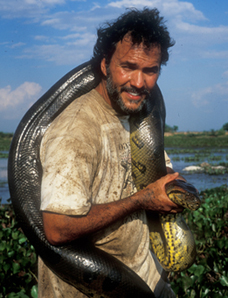Ph.D.
New Mexico Highlands University
Email: rivas@nmhu.edu

Faculty Information |
Overview
Education
Licenciatura in Biology,. Universidad Central de Venezuela, Caracas 1990
Ph.D. at Dept. of Ecology and Evolutionary Biology. University of Tennessee at Knoxville. 2000
Background
Assistant professor of Tropical Ecology at Boston University. Fall 1999 to Summer 2000.
Field on-air correspondent for National Geographic Television 2000- 2003
Visiting Scholar at the University of Tennessee 2003- 2005
Academic Director of the course Comparative Ecology and Conservation for the School for International Training (SIT) 2005.
Assistant Professor at Somerset Community College from Spring 2006-2010
Publications
Book Chapters
Rivas, J. Muñoz, M, Burghardt, G. and J Thorbjarnarson 2007. Sexual size dimorphism and mating system of the Green Anaconda (Eunectes murinus). pp: 312-325 In: R. W. Henderson, R. and Powell, G. W. (eds.), Biology of Boas, Pythons, and Related Taxa. Eagle Mountain Publishing Company, Eagle Mountain.
Rivas, J. A., M. d. C. Muñoz, J. B. Thorbjarnarson, G. M. Burghardt, W. Holmstrom, and P. Calle. 2007. Natural History of the green anacondas (Eunectes murinus) in the Venezuelan llanos. pp: 128-138. In: R. W. Henderson, and R. Powell, (eds.), Biology of Boas, Pythons, and Related Taxa. Eagle Mountain Publishing Company, Eagle Mountain.
Rivas, J. A. and Levin, L. 2004. Sex differential antipredator behavior in juvenile green iguanas, Iguana iguana: evidences for fraternal care. pp: 119-126. In Behavior, Diversity, and Conservation of Iguanas (Alberts, A. C., R. L. Carter, W. K. Hayes, and E. P. Martins, Eds.) University of California Press, Berkeley.
Rivas, J. A., Rodriguez, J. V., and C. G. Mittermeier 2002. The llanos. pp: 265-273. In Mittermeier, R.A. (ed.) Wildernesses. CEMEX, Mexico.
Rivas, J. A. and G. M. Burghardt. 2002 Crotalomorphism: A metaphor to understand anthropomorphism by omission. pp: 9- 17. In The Cognitive Animal: Empirical and Theoretical Perspectives on Animal Cognition. (Bekoff, M., Colin, A. and G. M. Burghardt, eds.) MIT Press, Cambridge, MA
Journal Articles
Rivas, J. A. 2010. Is Wildlife Management Business of Conservation: A Question of Ideology. Reptiles and Amphibians 17: 112-115.
Rivas, J. A. & S. J. Corey. 2008 Eunectes murinus (green anaconda). Longevity. Herpetological Review. 39: 469.
Rivas, J. A. 2008. Ticks (Amblyomma spp.) on Black Iguanas (Ctenosaura similis) in Costa Rica. Iguana. 15: 25-27.
Rivas, J. A.; Ascanio R. & M. D Muñoz. 2008. What is the length of a snake? Contemporary Herpetology. 2008(2): 1-3
Rivas, J. A. 2007 Conservation of Anacondas: How Tylenol Conservation and Macroeconomics Threaten the Survival of the World’s Largest Snake. Iguana. 14:10-21.
Rivas J. A. and G. M. Burghardt 2005. Snake mating systems, behavior, and evolution: The revisionary implications of recent findings. Journal of Comparative Psychology 119: 447-454
White, J. M. and J. A. Rivas, 2003. Paleosuchus trigonatus (Dwarf Caiman) Neonate time budget. Herpetological Review. 34 (2): 141.
Rivas, J. A. and R. Y. Owens 2002. Crocodylus intermedius (Orinoco crocodile): age at first reproduction Herpetological Review. 33(3): 203.
Rivas, J. A. and Burghardt G. M. 2001 Sexual size dimorphism in snakes: wearing the snake’s shoes. Animal Behaviour. 62(3): F1-F6.
Rivas, J. A. and R. Y. Owens. 1999. Teaching conservation effectively: a lesson from life history strategies. Conservation Biology. 13 (2): 453-454
Rivas, J. A. 1998. The miracle of universities. Conservation Biology. Vol 12(6): 1169-1170.
Rivas, J. A. 1997 Natural history: hobby or science? Conservation Biology.: 11(3): 811-812.
Rivas, J. A., Muñoz M del C., Thorbjarnarson, J. B., Holmstrom, W. and Calle P. 1995. A
safe method for handling large snakes in the field. Herpetological Review. 26: 138-139
Presentations
Appearances
Courses
Evolution 476/576
Senior Project 491 & 492
Human anatomy and Physiology 231 & 232
